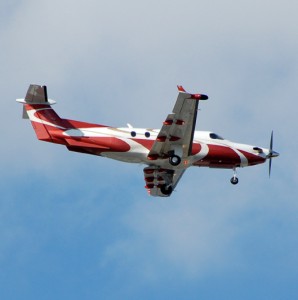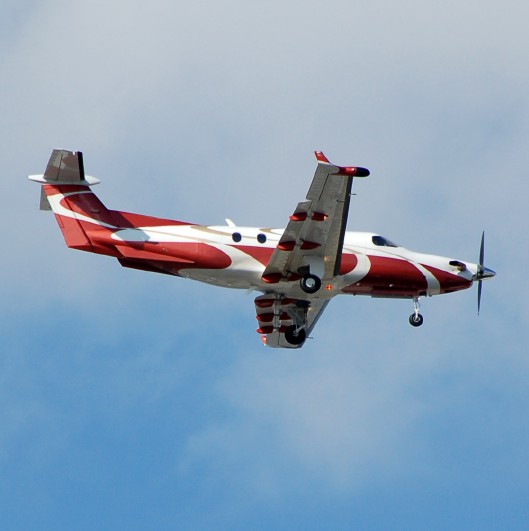 Single pilot (SP) IFR flying is a perfectly choreographed tango between the pilot and his/her skills (stick & rudder, knowledge, experience, common sense, systems management), and a dance partner (aircraft) with just as much capability. Luckily for us, the PC-12NG is the perfect dance partner. What’s more, there are many ingredients to a successful SP IFR flight. Most are taught at the very basic level of IFR training; however, as aircraft become more technologically advanced and pilots stray from the “fresh out of instrument training” mentality, the outcome is not always one that is consistently safe. Consistency and standardization are what we strive for as PC-12 drivers. We must remember the basic concepts learned on the initial IFR rating (preflight planning, SOP’s, cockpit organization, remaining AHEAD of the aircraft, utilizing time efficiently, SRM-Single pilot Resource Management, ATC management, and flying the airplane) and use these together with the latest automation to yield successful outcomes. Follow along as I take you on my SP IFR flight departing KPTK to KOXC. As the flight unfolds, I’ll run through my thought processes and procedures used to accomplish a safe flight. It is my belief that you’re only as successful as your last flight; my knowledge is not gospel. Rather, these are my techniques that I used to safely fly many SP IFR flights. Though confidence is a useful tool when making SP decisions, over-confidence WILL get the best of you. Additionally, as you progress through the article, you’ll see techniques I find useful in bold. Let’s begin.
Single pilot (SP) IFR flying is a perfectly choreographed tango between the pilot and his/her skills (stick & rudder, knowledge, experience, common sense, systems management), and a dance partner (aircraft) with just as much capability. Luckily for us, the PC-12NG is the perfect dance partner. What’s more, there are many ingredients to a successful SP IFR flight. Most are taught at the very basic level of IFR training; however, as aircraft become more technologically advanced and pilots stray from the “fresh out of instrument training” mentality, the outcome is not always one that is consistently safe. Consistency and standardization are what we strive for as PC-12 drivers. We must remember the basic concepts learned on the initial IFR rating (preflight planning, SOP’s, cockpit organization, remaining AHEAD of the aircraft, utilizing time efficiently, SRM-Single pilot Resource Management, ATC management, and flying the airplane) and use these together with the latest automation to yield successful outcomes. Follow along as I take you on my SP IFR flight departing KPTK to KOXC. As the flight unfolds, I’ll run through my thought processes and procedures used to accomplish a safe flight. It is my belief that you’re only as successful as your last flight; my knowledge is not gospel. Rather, these are my techniques that I used to safely fly many SP IFR flights. Though confidence is a useful tool when making SP decisions, over-confidence WILL get the best of you. Additionally, as you progress through the article, you’ll see techniques I find useful in bold. Let’s begin.
Conditions: Late November, night, IMC.
Planning considerations:
1) Single engine precautions- Terrain, performance, weather, altitudes, etc.
2) Freezing levels (Use of on board de-icing equipment as a way to safely depart icing conditions. Not a license to stay in it)
3) Fuel: Route, approach, missed approach, and alternate fuel per FAR’s.
4) Preferred routes– Plan what you’re most likely going to receive, rather than something based on assumption.
5) Suitable destination alternate and “escape plans” to mitigate as much risk
as possible along the route.
Remember, you’re exponentially better off making as many decisions as possible while on the ground. Subsequent decisions made in the air are that much more consuming. The planning stage is now complete and we move on to aircraft prep. Stepping into the airplane, the first thing I do is organize and situate myself in a methodical manner. Luckily for the single pilot, organization is made easy due to the ample room up front- sans co-pilot. Cerebrally, I’m running through a flow and then subsequent checklist; a theme you’ll hear repeatedly. Next I place my printed flight plan and scratch sheet on a clip board (because loose papers are a single pilots’ nemesis in IMC). I keep them neatly in one place. Doing so helps facilitate (1) knowing exactly where loose leaf information is kept, and (2) makes for easy retrieval in the dark. Once situated, I configure the airplane. I’ve flown the PC-12 for a while. I understand the airplane and my procedures well; however, I still follow my flow and checklist procedures to a ‘T’. I can’t stress this enough. So many things happen simultaneously, it would be an injustice to operate otherwise. Similarly, you’ll hear me use “call outs” as if I were with a second pilot, in order to keep the standardization. After all the preflight checklists/setups are complete, I give a final check of the weather en route and at my destination (hail to the Ipad!) and we’re ready to go.
The winds are light, and the departure runway is my choice. I elect to take off from 9R- the runway that will allow me to have the ILS right behind me should I need to make a 180 back (altitude dependent). I select it in preview. Again, better to set it and forget it than struggle in IMC at 1000ft. The radar’s on (to actually see what’s ahead), checks are complete, and we’re off. Regarding NEXRAD, well, it’s a beautiful thing, but understand its limitations: Be aware of its time delay!
Advancing the power, I’m listening to the engine, sensing normal acceleration, and I’m watching the gauges simultaneously uttering my “callouts.” I rotate. No runway remaining, gear up. 400ft, I retract the flaps and at 1000ft, I’m running the climb flow and checklist. As I proceed upward, I’m hand flying with the flight director on. (No need to practice raw data flying in solid IMC) Why, you ask? Well, I like to hand fly shortly after takeoff in order to (1) understand the aircraft in the current conditions (2) bring my basic instrument scan up to speed, (3) keep things simple (automation wise) while close to the ground, and (4) have a little fun! After all, we’re Pilatus pilots; we fly because we enjoy the act of flying. Why drive a Porsche if all you want to do is sit back, set the cruise, and let the car drive you! We’re now picking up a little ice passing through 8,000ft and I’ve turned the autopilot on enabling me to focus on other necessary tasks as SP. I do disengage the autopilot periodically to feel the handling characteristics with the ice. I’m consciously aware that the autopilot can mask symptoms of “funny aircraft behavior.” Freeing my brain from having to move control surfaces, I now have time to manage the flight, evaluate “escape plans”, should a troubling situation arise, and search for my final cruise altitude, taking into account the environment and “emergency time” as a function of altitude and thus glide distance above the ground. Again, the beauty of the PC-12 is the flexibility in altitude planning. Though my planned Altitude was 25,000ft, I’ve settled on 21,000ft. A change in plan, yes, but as long as you’re managing your tasks and again have done your homework on the ground, you’ll find that any change is not a big deal. You’re prepared. Adjust and amend are important parts of single pilot flying.
In a crew environment, things generally calm down upon leveling off. As a SP, this is when I start taking advantage of down time. We’re now level, so I begin to plan for the descent, approach, and missed approach, should I have to initiate. I do so with the following: A check of destination weather- I’m assessing the reported winds, visibility, ceiling, and any other pertinent information; an initial runway plan according to the winds and visibility; subsequently building the approach by putting it into the FMS (As an aside, I set the full approach in order to have all fixes at my fingertips),then I place ATIS in standby radio two (yes, we’re far out, but I have it in there ready to go); and lastly I pull up the plate on the chart preview, briefing/ building everything I can. Sure, I’ve flown this approach many times; however, as a SP, complacency will be your worst enemy. For that matter, complacency is the enemy of a two, three, or a four person crew! Prepared as possible for the later stages of the flight, I can now focus on talking with ATC, finding shortcuts, andmonitoring the weather below me, near me, and at my destination. This helps me understand weather trends, and then I repeat all over again. Doing so helps me to remain vigilant, ready for a change, and demonstrates good airmanship.
Beginning my initial descent, there’s no sense of urgency now that I’m prepared. I’ve listened to ATIS and I’ve already called “in range.” The descent checklist is complete; I’m ahead of the curve. Descending back into the clouds I’m now picking up ice again. Remember, as part of good SRM, use ATC to your advantage. Ask for reports ahead and listen to others in the area and always remember that you’re PIC and it’s your butt in the seat. If you don’t like something, say something! Getting closer now, we’re leveled off on vectors to the approach. All checklists are done and the approach is loaded from earlier. I have a minute before our last vector to intercept, so now is a good time to set radio 2 active frequency to CTAF (making sure PCL lighting is the same frequency), announcing my position (still listening on radio one of course), and clicking the PCL 7 times to light up my arrival. I proceed to check outside for ice again. The GS is now coming in. I’m configuring the airplane and mentally preparing to head down. GS captured, I set the missed approach alt and I call out 1000ft above on profile; 500ft above on profile; 100ft above; minimums; runway in sight! (Autopilot off) We touch down, complete the after landing checks and taxi in. Another safe single pilot IFR flight accomplished!
The moral of this story is that the PC-12 is an inherently capable IFR airplane for single pilot flying. The systems on board and the manner in which the information is presented make the ergonomics of handling an IFR single pilot flight manageable and downright fun. Nevertheless, it’s up to you as the pilot to manage your PC-12 systems knowledge, stick and rudder skills, standardization, and workload management to facilitate a systematic and thus safe approach to flying alone. Common sense will also take you a long way.
Todd Hotes
Chief Pilot
Polymer Resources, LTD.

